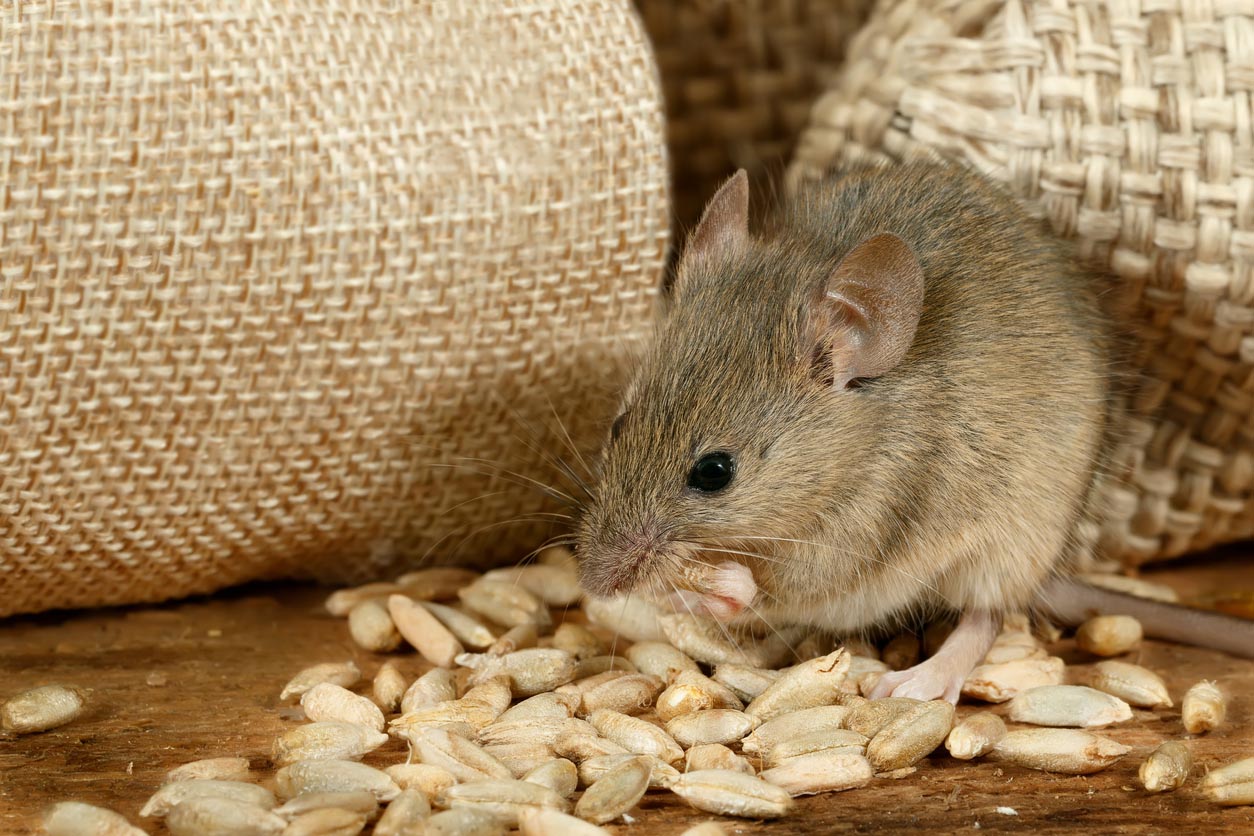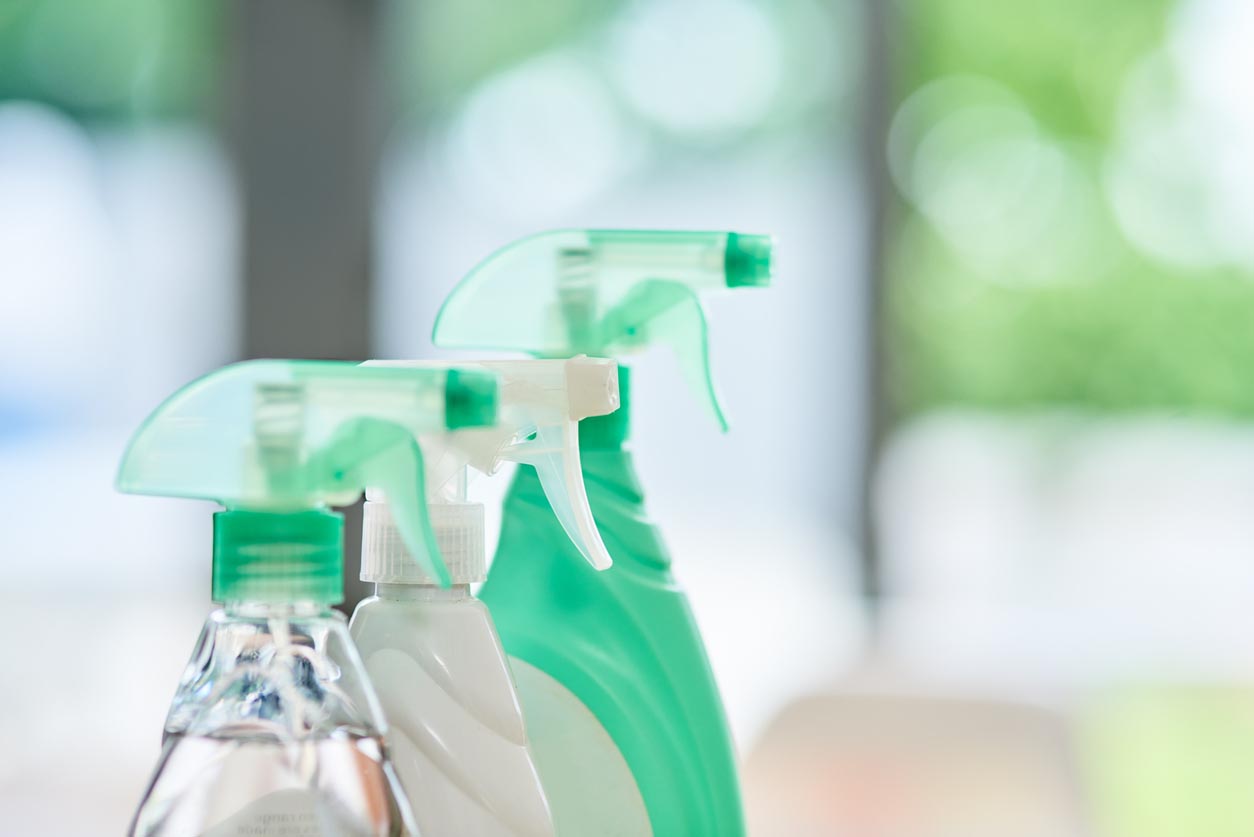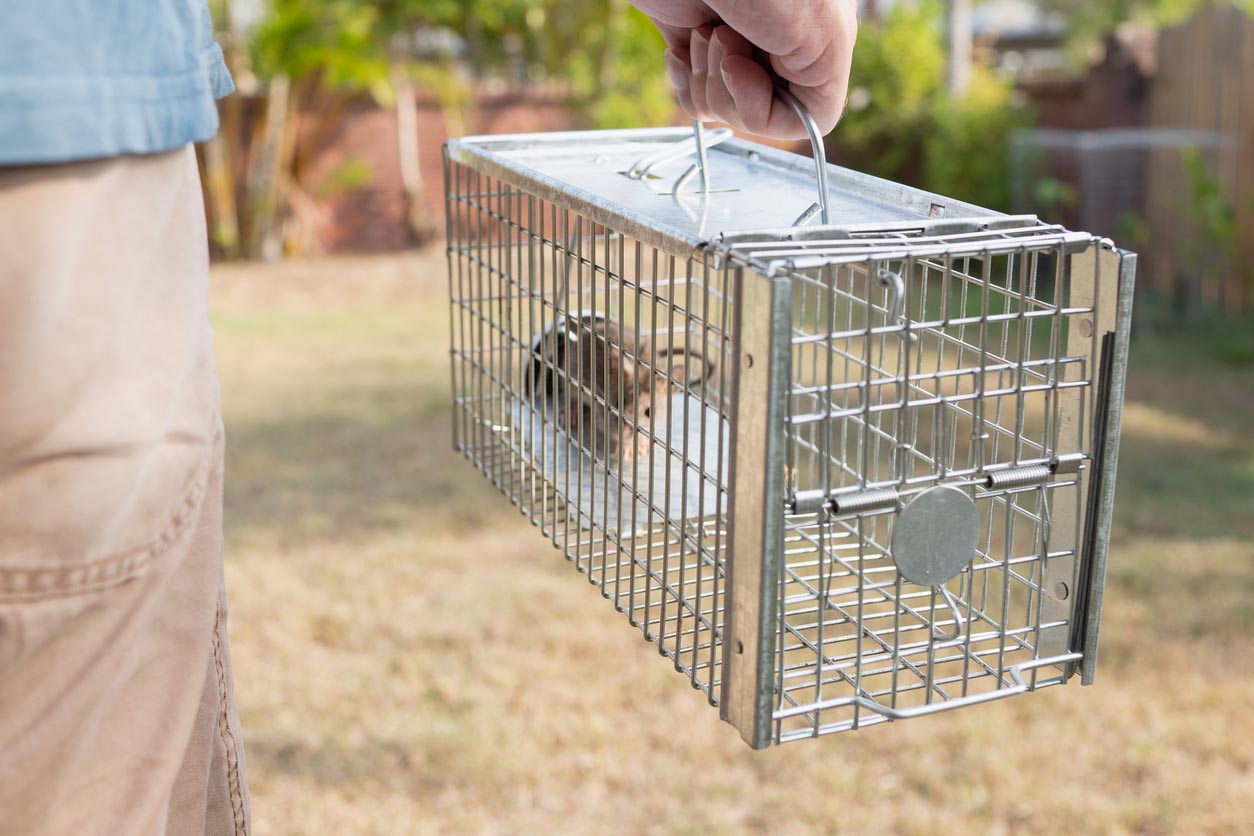

We may earn revenue from the products available on this page and participate in affiliate programs. Learn More ›
Project Overview
- Mice often make nests in a home’s basement or attic; plugging any holes or other entry points can prevent further infestations.
- Keeping food in airtight containers makes it less likely mice will come into a home looking for snacks.
- Homeowners will want to keep their home clutter-free, both inside and out, to discourage mice from coming into their homes.
- A professional can help a homeowner remove mice from their home humanely and safely.
A mouse infestation can be enough to make anyone skittish. Those pesky critters can carry a plethora of dangerous diseases and cause plenty of damage to the home, tearing up walls and wiring. Homeowners wondering, “How can I get rid of mice in the house?” will be pleased to learn that there are a variety of simple mouse infestation solutions, ranging from simple prevention techniques to DIY trapping methods that are safe and humane. This who aren’t interested in removing these rodents themselves can call one of the best pest control companies, like Terminix, Orkin, or Aptive, to do the dirty work.
Time required: 1 week to 3 months, depending on the severity of the infestation
Difficulty: Beginner
Estimated cost: $10 to $200
Tools & Materials
Bobvila.com may earn a commission from purchases made through these links.
- ¼-inch hardware cloth
- Ultrasonic mouse deterrents
- Mouse traps
- Cat litter
- Dried snake feces
- Rodent poison
Before You Begin…
Mice are nocturnal animals, so they tend to stay out of sight during the day. For this reason, it might not be obvious right away that mice are taking up residence in a home. Homeowners can keep an eye out for streaks of dirt along floors and walls, noises in the walls at night, droppings around the house, or a dead mouse smell in the house. Keeping the home clean and free of clutter will make it easier for a homeowner to spot these unpleasant signs of a mouse infestation and make it a less welcoming space for rodents.
Tips for Getting Rid of Mice
- Identify and fill in gaps where mice can enter the home.
- Eliminate potential food sources like crumbs.
- Utilize natural deterrents such as peppermint oil.
Safety Considerations
- Use caution when handling mouse droppings or dead mice as they can carry harmful diseases and bacteria.
- If it is absolutely necessary to use pesticides, be sure that they are placed out of reach of children and pets.
STEP 1: Identify entry points.
For homeowners wondering, “Why do I have mice in my house?” the simplest explanation is that they were able to find a way inside. No matter what method a homeowner turns to for mouse control, as long as mice have easy access to the home, the problem is likely to persist.
Basements and crawl spaces are common rodent entry points simply because they are located at the ground level and may be prone to cracks. Mice can also slip into attics through gaps where the roof meets the walls. In some cases, mice may even be able to squeeze through gaps in windows and doorways that are not completely airtight.
There are several ways to identify potential entry points; knowing what mouse poop looks like and how to recognize mouse tracks can help homeowners pinpoint likely locations. After locating potential entry points, it’s worth looking for signs of mouse activity for confirmation. These can include gnaw marks, mouse droppings, or grease marks where mice have rubbed against walls or floors and left behind dirt.
STEP 2: Plug all holes.
Mice can squeeze through a hole the size of a nickel, so homeowners will want to stay vigilant by carefully inspecting their home’s interior and exterior walls as well as the foundation for holes. Emory Matts, board certified entomologist and a technical service manager for Rentokil Terminix, advises homeowners to “seal up any gaps greater than a quarter inch (6 millimeters). Seal up any holes greater than a half inch (10 millimeters). The gap or hole should first be filled with a rodent-resistant material such as metal wool and then held in place with a sealant or other appropriate materials.” Large holes or cracks will need to be repaired; small ones can be filled with steel wool or copper scouring pads. It’s advised that homeowners secure the plug to the sides of the hole so the mice cannot pull it out.
STEP 3: Eliminate food sources.
Mice won’t stick around a home that doesn’t offer a steady supply of food and water, so homeowners will want to get rid of the obvious sources of sustenance first. It’s important to make sure food items are completely sealed up before being put away (especially pet food and birdseed), that stovetop spills are wiped up promptly, and that any leaky faucets are fixed.
Mice have sharp teeth that are capable of chewing through packaging easily, so as an added precaution, it may be worth transferring food items like cereal into airtight containers. Equally important, homeowners will want to seal all trash cans tightly, empty them frequently, and move their exterior trash cans as far away from their home as possible to avoid attracting mice or other pests.

STEP 4: Remove potential shelter.
Once they have found a safe spot to nest within the home, mice will likely begin reproducing. Identifying and removing places of shelter is essential to stop an infestation from progressing. Since mice tend to prefer to nest near their food sources, it may be wise to start the search in the kitchen. Some common hiding spots include behind appliances, on top of cabinets, and inside pantries.
Mice are also commonly found in attics, basements, and crawl spaces. They may even gnaw through upholstery and make their nests inside large pieces of furniture. It may not be possible to see mice in the walls, but homeowners will still likely be able to tell that they are there. “You may hear mice squeaking, gnawing, or traveling through the walls. They may also leave behind droppings and gnawed materials,” explains Matts.
Once a mouse nest in the house has been found, it will need to be disposed of and the area cleaned. If possible, it’s also a good idea to block any previous access points by caulking or patching holes.
STEP 5: Keep up with home maintenance.
Homeowners will want to replace cracked or broken weatherstripping around doors and windows to ensure that pests (and drafts) cannot enter. They’ll need to cover the dryer vent or any other exterior vents with ¼-inch hardware cloth and make sure to seal up any spaces around window- or wall-mounted air conditioners.
STEP 6: Clear outdoor clutter.
Keeping the outside of a home clean and tidy removes potential hiding places for mice around the house, garage, and yard. Homeowners will want to prevent weeds, brush, or trash from piling up near the foundation. According to PestWorld.org, it’s also a good idea to keep wood piles at a distance of at least 20 feet away from the house and keep shrubbery neatly pruned.
Homeowners can look into natural ways to kill weeds, or consider hiring one of the best lawn care services (such as TruGreen) to keep the exterior of their home looking presentable.

STEP 7: Clean out your garage.
Mice aren’t too picky when it comes to choosing a place to nest—their priorities are shelter and access to food and water. If they can find those elements in a garage, or even under the hood of a car, they will make their home there. Homeowners can reduce clutter where mice can hide their nests by storing items on shelves or in sealed containers. They can also make sure any holes or gaps in the garage’s siding are patched.
This is especially important for houses with attached garages, as the garage can serve as an easy entry point to the home. Homeowners will also want to consider moving any extra food or pet bowls that are stored in the garage to another location that is out of reach of rodents.
STEP 8: Try a natural deterrent.
Essential oils are one of the most natural ways to get rid of mice. Homeowners can put a few drops of peppermint or clove oil on cotton balls and place them at potential mouse entrances to deter them from the home. Alternatively, another option is to make a spray to address these same spots using 1 teaspoon of peppermint or clove oil and 3 cups of warm water.
STEP 9: House a purr-fect predator.
Homeowners can find a tomcat for their Jerry by visiting their local animal shelter and asking to foster or adopt nature’s own mouse-control system: a cat. Even the most pampered kitty will turn into a huntress when confronted with a mouse. Plus, homeowners will get the added benefit of a warm and fluffy companion long after mouse-hunting season is over.
STEP 10: Reuse and recycle.
To deter mice, homeowners can scoop used cat litter and scatter it outside around the home’s perimeter. Mice will smell the cat waste and stay away. Dried snake poop from a pet store also gets the job done. Homeowners may want to place the waste products in containers so that children and pets don’t play with the mess.
STEP 11: Zap ’em with ultrasonic sound.
Homeowners can try using ultrasonic electronics to keep mice at bay. Available at hardware stores and home centers, these units emit ultrasonic beeps or whines that ward off rodents. These sounds will also annoy dogs and cats, though, and work only if the mice are in close proximity.

STEP 12: Consider a humane approach.
Rather than harming the mice, homeowners may want to consider a humane approach by catching and releasing the critters using a commercial box trap. Or they can make a similar device on their own by placing some chocolate on a tray and covering it with an inverted large bowl, lifting one side of the bowl, and standing a quarter or half-dollar underneath to keep the container tilted. When the mouse scurries underneath for the chocolate, it will knock over the coin and cause the bowl to drop. Once the homeowner has the mouse trapped, they will want to release it at least 1 mile from their home, preferably in a wooded area.
STEP 13: Trap if you must.
The best mouse traps, while old school, can be effective when other methods fail. According to Matts, “Baited snap traps can be very effective at catching mice. It is important to maintain fresh bait on the traps and use foods that the mice are eating. Position the traps in areas such as along walls, in corners, and other areas where the mice will likely travel near the traps.” Conventional snap or glue traps can be baited with peanut butter or cheese and placed where there are mouse droppings, especially under sinks, inside drawers, and behind furniture. There are several types of mouse traps for homeowners to choose from, including the following.
- Bait stations are one of the cheapest and most effective options, but they have a few downsides. Since a mouse is likely to leave the area after ingesting the poison, it may die in an unknown location within the home. Bait stations can also be dangerous if they are accessible to children or pets.
- Electronic traps are effective, relatively humane, and safe. These traps consist of a baited enclosed box, and mice are instantly shocked upon entering. This spares the homeowner from having to see the mouse when emptying the trap. While electronic traps are relatively costly, they can be used many times.
- Live traps are a good choice for those who prefer to remove mice rather than killing them. Once trapped, mice will need to be transported away from the home, which may result in a lot of driving if many mice are caught. Since this option requires coming into contact with the mice, there is also a risk of disease transmission.
- Snap traps are a simple, low-cost option that kills mice instantly. Classic snap traps can be unpleasant to some as the dead mice are fully visible, but there are also enclosed options on the market. Enclosed snap traps may also be safer for homes with children or pets.
Homeowners will want to check the traps daily, and use plastic gloves or a plastic bag to remove any mice—they will not want to touch a dead mouse with bare hands. They’ll also want to deposit the dead mouse immediately in an outdoor trash can.
STEP 14: Carefully consider pesticides.
When homeowners are researching “what can I put down for mice?” a common answer is one of the best mouse poisons or pesticides. Although many rodent poisons line the shelves of home improvement stores, some mice can be resistant to arsenic or anticoagulant poisons like warfarin. Moreover, rodent poison is extremely toxic to humans and other animals, and it shouldn’t be used around children or pets.
Homeowners will also want to remember that an animal that eats a poisoned rodent can become sick or die, so they’ll want to think twice about this option before picking up a box of pellets, and consider consulting a professional to make sure they are used safely.
STEP 15: Consider hiring a professional.
It’s stressful enough for a homeowner to realize that mice have infiltrated their home and will not leave of their own accord. If home remedies to get rid of mice are not working or the problem is severe, enlisting one of the best mouse exterminators is a great way for a homeowner to make sure the problem is taken care of for good. “[A] few mice…can usually be handled by the homeowner,” says Matts. “However, if there are many mice, rats, unknown damage, or unique structures, a professional is better equipped to eliminate the issue promptly and thoroughly. They can also provide services that may prevent future issues.”
Mice aren’t just a nuisance; their presence can also be a health hazard. So how do exterminators get rid of mice? Pest control technicians have advanced tools and the experience to remove mice and their droppings without further contaminating the home. They know how to get rid of mice in the walls and other areas that are difficult to access. In addition, many professionals carry humane lethal traps or use capture-and-release methods that are kinder to the wildlife than traditional traps or pesticides. On average, a mouse exterminator costs $176 to $579, which may be well worth it to get rid of the problem for good.
STEP 16: Prevent future infestations.
Eliminating the conditions that attract mice in the first place is essential to ridding the home of rodents for good. Mice have a unique ability to wiggle through what seem like impossibly small spaces wherever they can find them. First, the homeowner will want to repair any gaps in doors or siding with duct tape, caulk, or steel wool. They’ll also want to keep up on maintaining grass and shrubbery, as an overgrown lawn can attract all kinds of critters—not just mice. Inside the home, they’ll want to repair any leaks or damp areas in basements and attics. They’ll also want to double-check packages or other containers that have been outside for stowaways before bringing them indoors.
Mice are notorious for reproducing very quickly, so time is of the essence when it comes to dealing with a mouse infestation. Even if a homeowner has only seen one mouse, the odds are that more are nesting nearby. Taking the actions outlined above should discourage these unwanted visitors from becoming permanent residents. But if the problem persists, it may be worth scheduling an appointment with a pest control service that knows how to get rid of mice in the house for good.
Pest control costs are not insignificant, but they may be worth it to return the home to a safe and peaceful state. Homeowners will want to remember that, while mice are not dangerous or aggressive creatures, they have the potential to contaminate the home with viruses, bacteria, or even additional pests like fleas and mites. For the health and safety of everyone in the home, it’s important for a homeowner to be sure that mice are removed as soon as they become aware of the problem.
